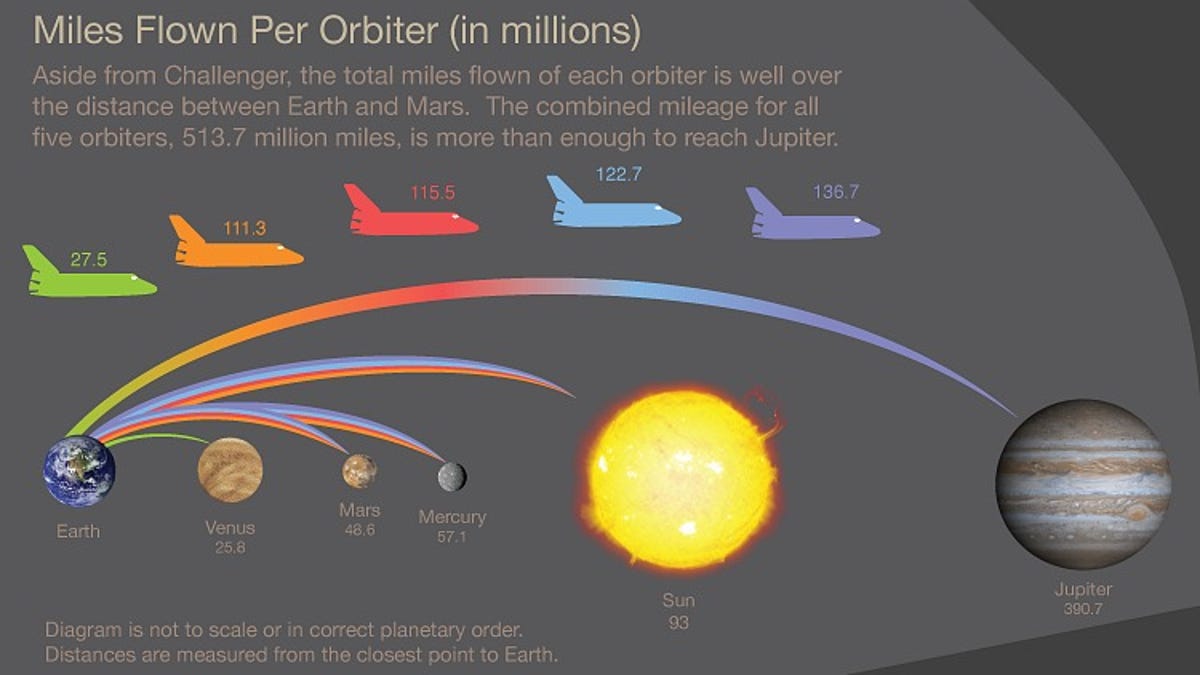Space shuttle program hits 30-year mark
In April 1981, the orbiter Columbia rode its rocket boosters into space and into the history books. Some 130 missions later, the shuttle fleet is on the cusp of retirement.
Thirty years on, NASA's space shuttle program is now in its last lap, but its place in history is assured.
On the morning of April 12, 1981, the shuttle Columbia, strapped to an enormous external fuel tank and a pair of solid rocket boosters, lifted off on its maiden voyage--and launched a new era in the Space Age. Never before had there been a spacecraft that could be used over and over again, that could land on Earth like an airplane--a glider, specifically.
That flight lasted 2 days, 6 hours, 20 minutes, and 53 seconds, in which time Columbia traveled 1.07 million miles, reaching an orbital altitude of 166 nautical miles. The two-man crew consisted of shuttle commander John Young and pilot Robert Crippen.
To date, the five spacecraft in the shuttle fleet have conducted more than 130 missions and traveled a cumulative half-billion miles--that's a lot of commuting into Earth's orbit and back. The shuttles (NASA also refers to them as orbiters) have been regular visitors to the International Space Station, ferrying crew members and supplies and experiments, but also whole new chambers for the orbiting laboratory. The shuttle Discovery trucked the Hubble Space Telescope into space in 1990, among other accomplishments; Discovery made its last flight earlier this year.
Related links
• Celebrating 50 years since Yuri Gagarin's 'Let's Go!"
• SpaceX building low-cost heavy-lift booster
• Air Force launches second mysterious space plane
Columbia was tragically lost, along with its seven-person crew, on February 1, 2003, during re-entry in the skies over Texas.
Later this month, the shuttle Endeavour is set to take off on its final mission, a 14-day sojourn in which it will visit the space station to deliver (among other things) a device called the Alpha Magnetic Spectrometer, intended to track cosmic rays. Next up after that, with a tentative launch date in late June, is Atlantis, on the docket for the very last shuttle mission of all.
To commemorate the 30th anniversary of Columbia's 1981 voyage--"the first time in history," NASA points out, that "a new spacecraft was launched on its maiden voyage with a crew aboard"--the U.S. space agency has set up a slick feature with a handy overview of the shuttle's size, launch sequence, crews, and more. The factoids can be fun ("It would take approximately 13.4 African elephants to equal the weight of the Space Shuttle Columbia"), but the feature is just a teaser, really, compared with far more in-depth resources in the Space Shuttle section of NASA's expansive Web site.
Among the historical documents to be found there is the press kit (PDF) from the debut shuttle flight, STS-1. Here's a bit of what it had to say about what Columbia would be up to:
STS-1 and the three flights following are engineering test flights to prove out the Shuttle system in launch, orbital and landing operations. As the first manned orbital flight, STS-l's flight profile has been designed to minimize structural and operational loads on the spacecraft and its boosters. Orbiter Columbia's cargo bay will be bare for this first test flight except for a data collection and recording package called developmental flight instrumentation (DPI) and an aerodynamic coefficient identification package (ACIP).
The data collection package consists of three magnetic tape recorders, wideband frequency division multiplexers, a pulse code modulation master unit and signal conditioners. The recorders can record 28 tracks of wideband analog data on systems conditions and performance simultaneously. This package will be removed after STS-4 from Columbia's cargo bay, where it is mounted at fuselage station 1069. The aerodynamic package is described under the "orbital Experiments Program."
The press kit also reveals that the first meal to be consumed in the Columbia on launch day would have been frankfurters (thermostabilized), turkey tetrazzini (rehydratable), bread (irradiated, "natural form"), bananas (freeze-dried), almond crunch bar (natural form), and apple drink (rehydratable).
We're marking the occasion by rerunning a slideshow we did last year at this time, harkening back to that first flight by Columbia, which as it turned out commenced on the 20th anniversary of Yuri Gagarin's historic flight into space. We also wanted to point you to several other looks at shuttle history--from the shuttle prototype Enterprise (yes, indeed, there is a "Star Trek" angle) to the Discovery, which flew more missions than any other spacecraft, to the Boeing 747 that ferries the shuttle around between terrestrial locales.


